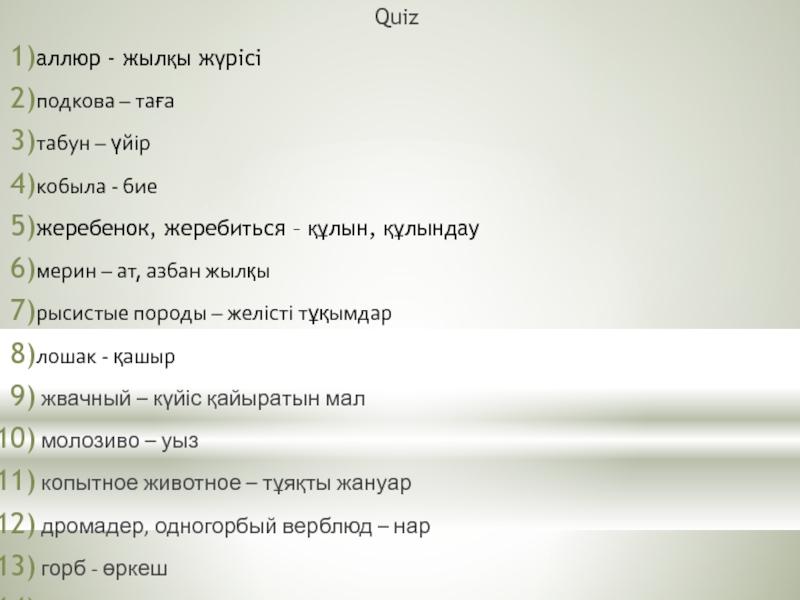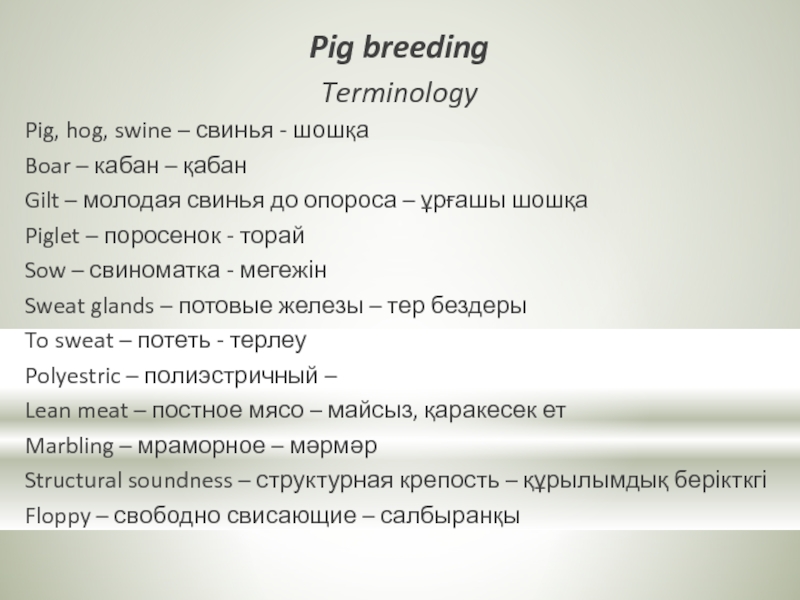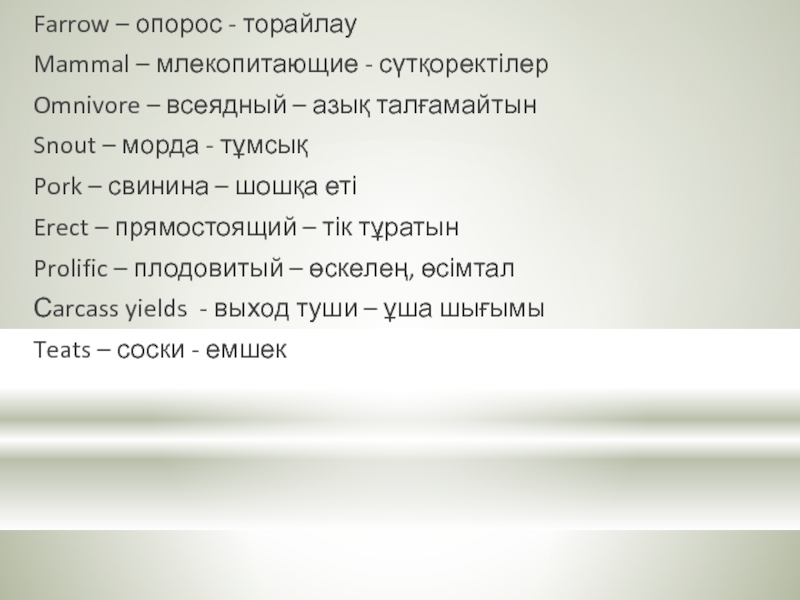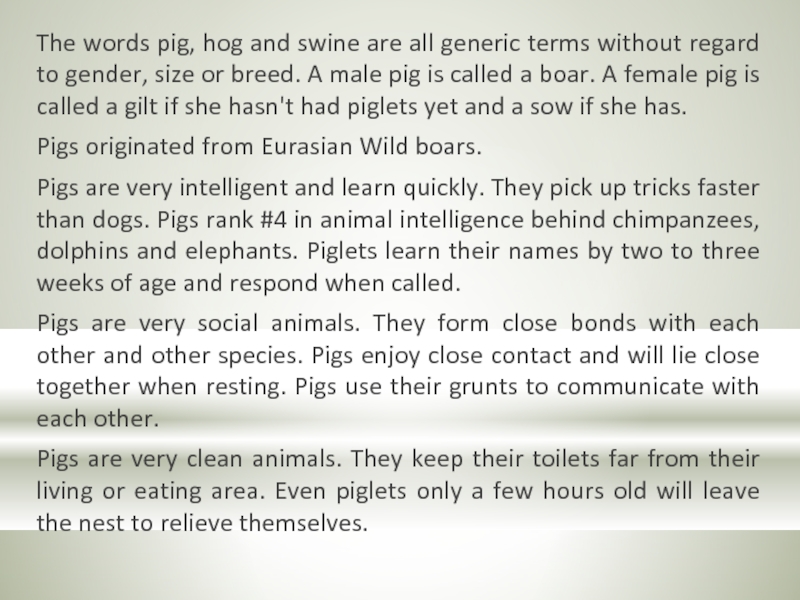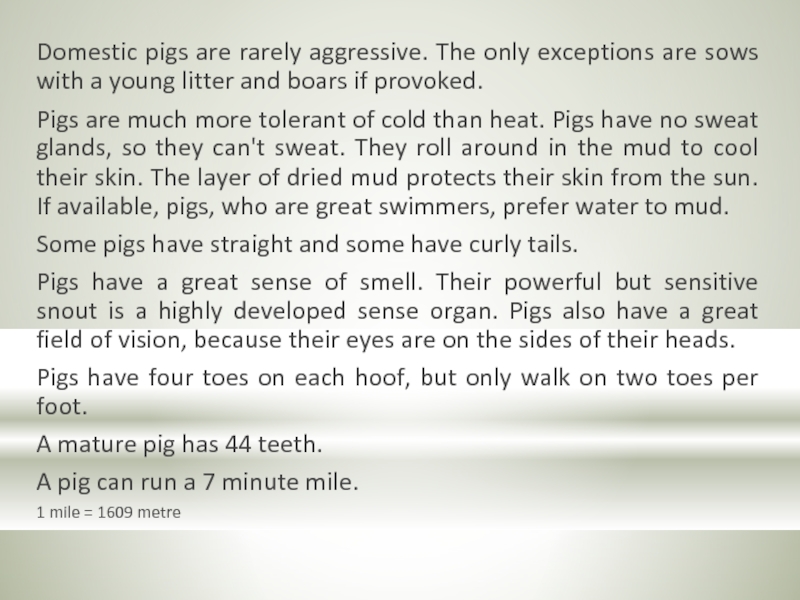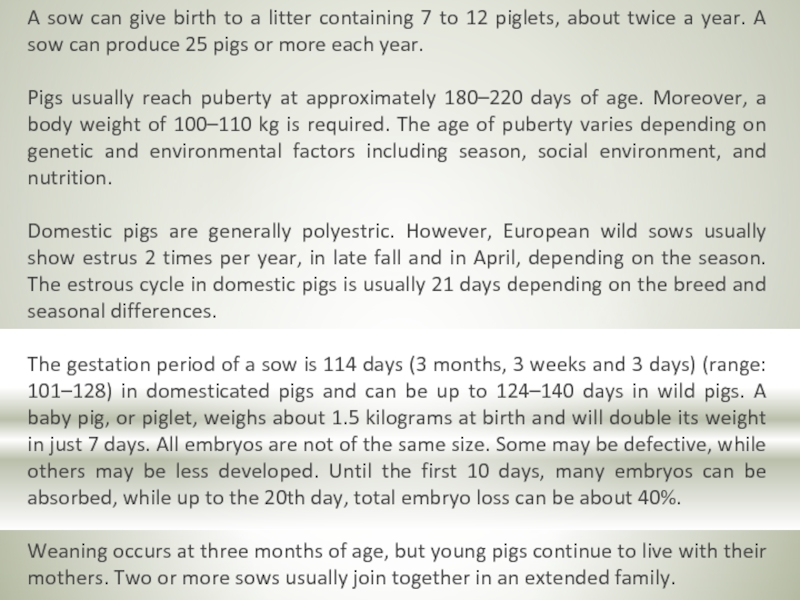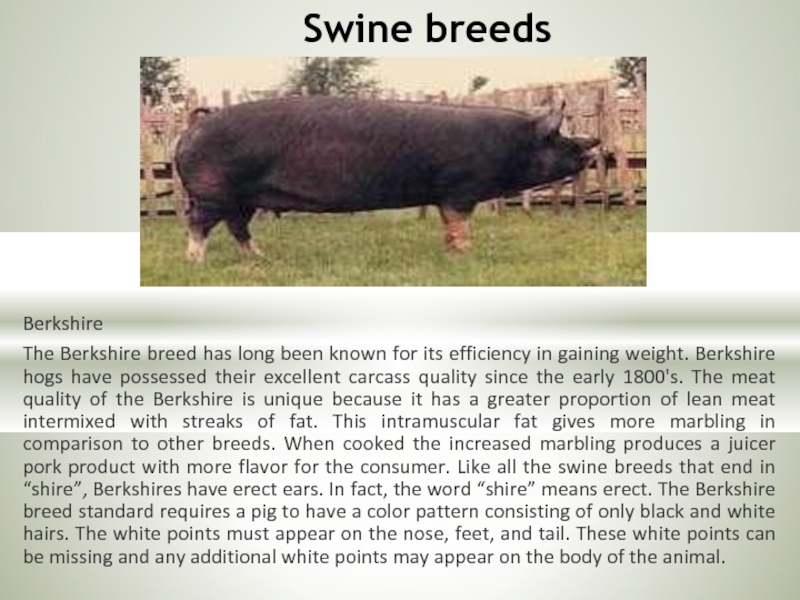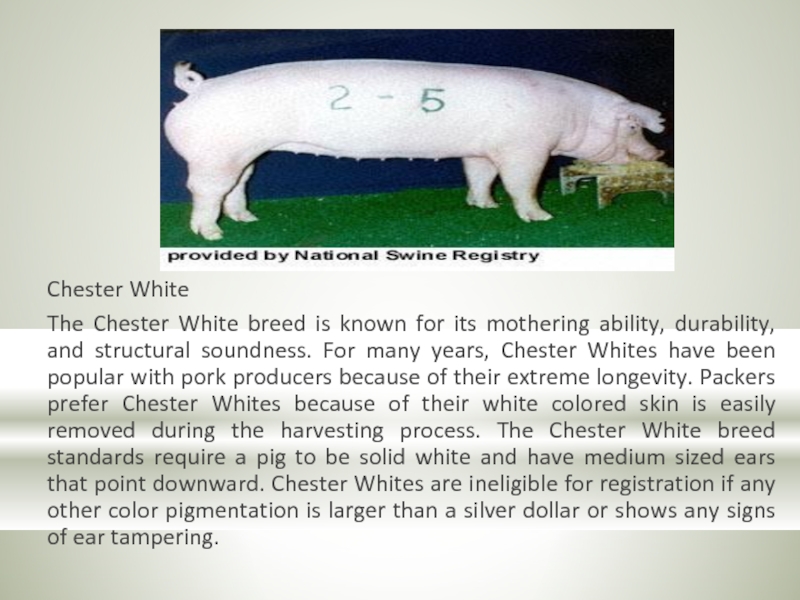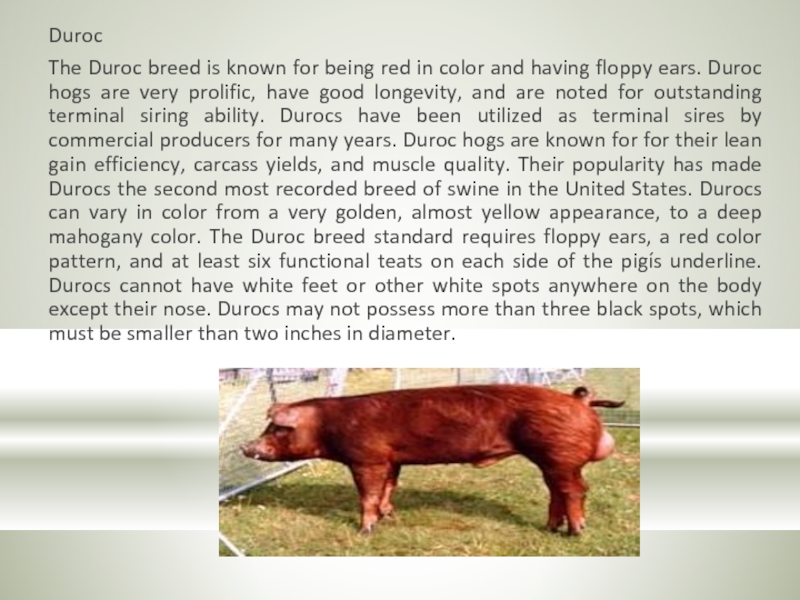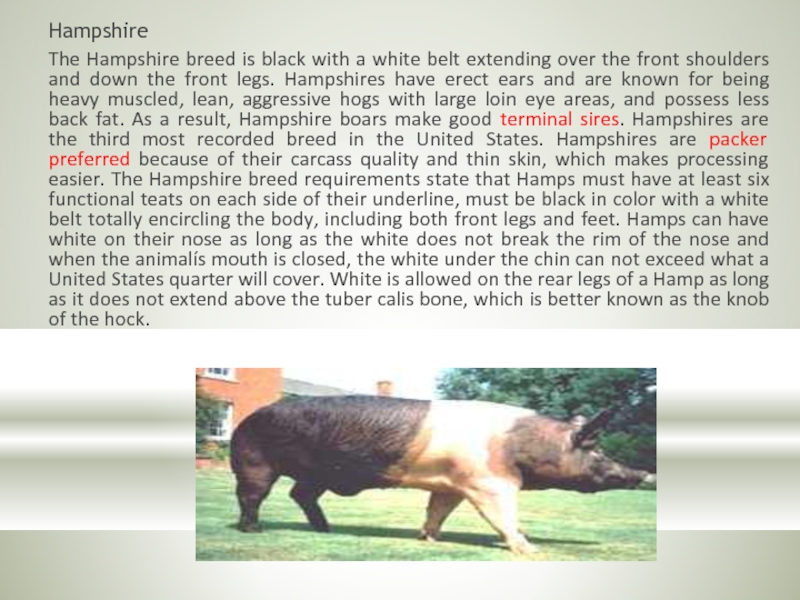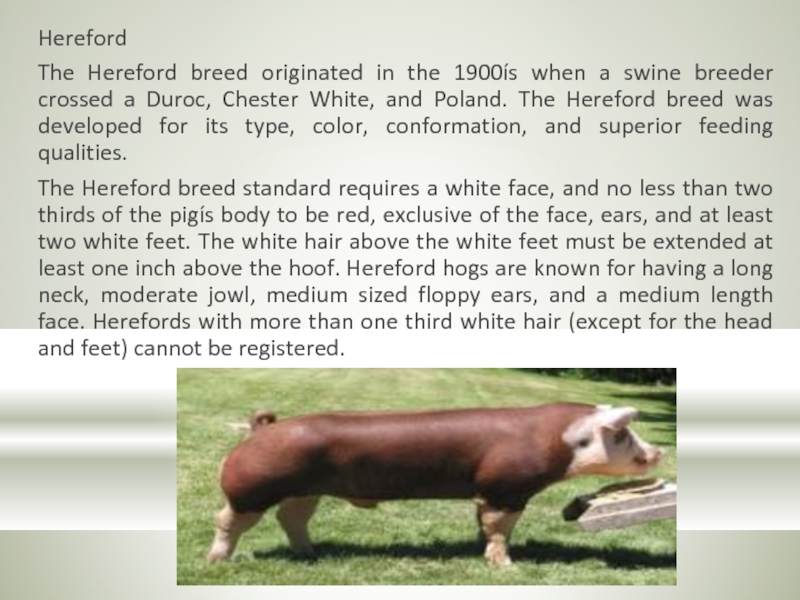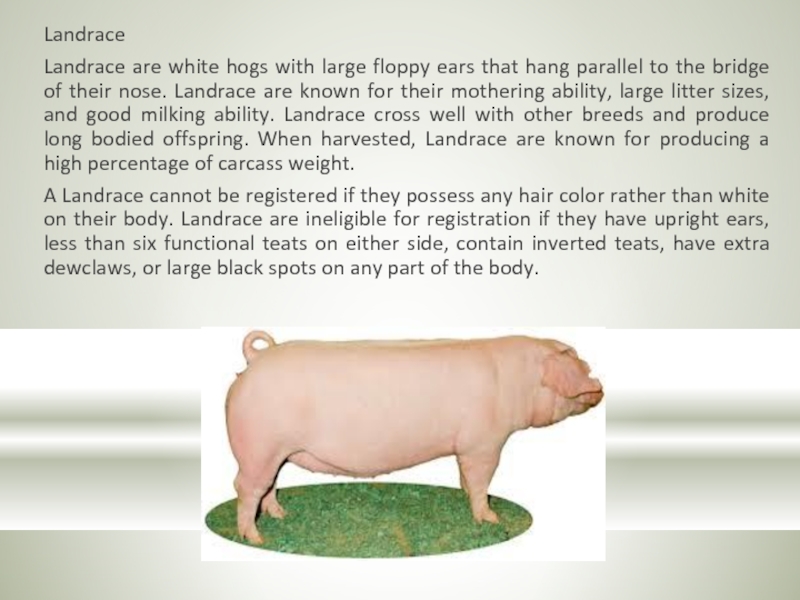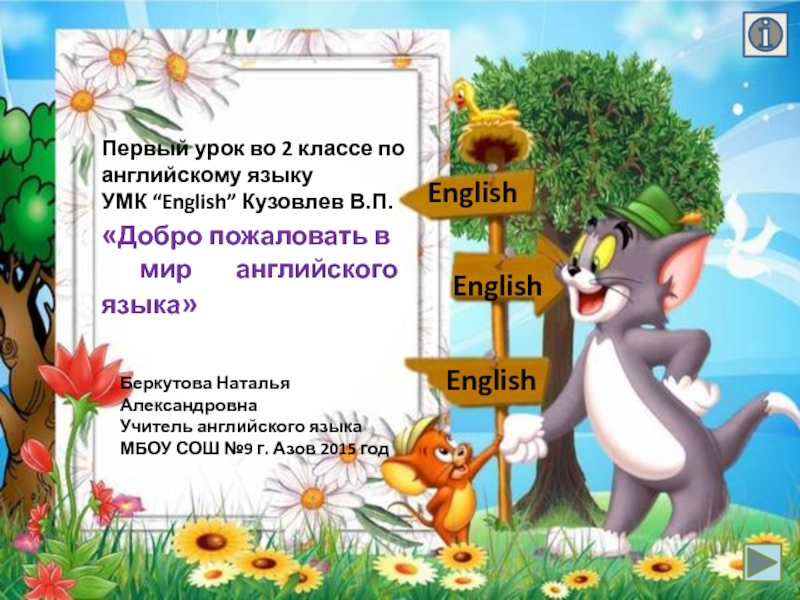– құлын, құлындау
мерин – ат, азбан жылқы
рысистые породы – желісті тұқымдар
лошак - қашыр
жвачный – күйіс қайыратын мал
молозиво – уыз
копытное животное – тұяқты жануар
дромадер, одногорбый верблюд – нар
горб - өркеш
трехкамерный желудок - үш камералы қарын
копыто - тұяқ
- Главная
- Разное
- Дизайн
- Бизнес и предпринимательство
- Аналитика
- Образование
- Развлечения
- Красота и здоровье
- Финансы
- Государство
- Путешествия
- Спорт
- Недвижимость
- Армия
- Графика
- Культурология
- Еда и кулинария
- Лингвистика
- Английский язык
- Астрономия
- Алгебра
- Биология
- География
- Детские презентации
- Информатика
- История
- Литература
- Маркетинг
- Математика
- Медицина
- Менеджмент
- Музыка
- МХК
- Немецкий язык
- ОБЖ
- Обществознание
- Окружающий мир
- Педагогика
- Русский язык
- Технология
- Физика
- Философия
- Химия
- Шаблоны, картинки для презентаций
- Экология
- Экономика
- Юриспруденция
Pig breeding презентация
Содержание
- 1. Pig breeding
- 2. Pig breeding Terminology Pig, hog, swine –
- 3. Farrow – опорос - торайлау Mammal –
- 4. The words pig, hog and swine are
- 5. Domestic pigs are rarely aggressive. The only
- 6. A sow can give birth to a
- 7. Berkshire The Berkshire breed has long
- 8. Chester White The Chester White breed
- 9. Duroc The Duroc breed is known
- 10. Hampshire The Hampshire breed is black
- 11. Hereford The Hereford breed originated in
- 12. Landrace Landrace are white hogs with
- 13. Yorkshire The Yorkshire breed is white
Слайд 2Pig breeding
Terminology
Pig, hog, swine – свинья - шошқа
Boar – кабан –
қабан
Gilt – молодая свинья до опороса – ұрғашы шошқа
Piglet – поросенок - торай
Sow – свиноматка - мегежін
Sweat glands – потовые железы – тер бездеры
To sweat – потеть - терлеу
Polyestric – полиэстричный –
Lean meat – постное мясо – майсыз, қаракесек ет
Marbling – мраморное – мәрмәр
Structural soundness – структурная крепость – құрылымдық берікткгі
Floppy – свободно свисающие – салбыранқы
Gilt – молодая свинья до опороса – ұрғашы шошқа
Piglet – поросенок - торай
Sow – свиноматка - мегежін
Sweat glands – потовые железы – тер бездеры
To sweat – потеть - терлеу
Polyestric – полиэстричный –
Lean meat – постное мясо – майсыз, қаракесек ет
Marbling – мраморное – мәрмәр
Structural soundness – структурная крепость – құрылымдық берікткгі
Floppy – свободно свисающие – салбыранқы
Слайд 3Farrow – опорос - торайлау
Mammal – млекопитающие - сүтқоректілер
Omnivore – всеядный
– азық талғамайтын
Snout – морда - тұмсық
Pork – свинина – шошқа еті
Erect – прямостоящий – тік тұратын
Prolific – плодовитый – өскелең, өсімтал
Сarcass yields - выход туши – ұша шығымы
Teats – соски - емшек
Snout – морда - тұмсық
Pork – свинина – шошқа еті
Erect – прямостоящий – тік тұратын
Prolific – плодовитый – өскелең, өсімтал
Сarcass yields - выход туши – ұша шығымы
Teats – соски - емшек
Слайд 4The words pig, hog and swine are all generic terms without
regard to gender, size or breed. A male pig is called a boar. A female pig is called a gilt if she hasn't had piglets yet and a sow if she has.
Pigs originated from Eurasian Wild boars.
Pigs are very intelligent and learn quickly. They pick up tricks faster than dogs. Pigs rank #4 in animal intelligence behind chimpanzees, dolphins and elephants. Piglets learn their names by two to three weeks of age and respond when called.
Pigs are very social animals. They form close bonds with each other and other species. Pigs enjoy close contact and will lie close together when resting. Pigs use their grunts to communicate with each other.
Pigs are very clean animals. They keep their toilets far from their living or eating area. Even piglets only a few hours old will leave the nest to relieve themselves.
Pigs originated from Eurasian Wild boars.
Pigs are very intelligent and learn quickly. They pick up tricks faster than dogs. Pigs rank #4 in animal intelligence behind chimpanzees, dolphins and elephants. Piglets learn their names by two to three weeks of age and respond when called.
Pigs are very social animals. They form close bonds with each other and other species. Pigs enjoy close contact and will lie close together when resting. Pigs use their grunts to communicate with each other.
Pigs are very clean animals. They keep their toilets far from their living or eating area. Even piglets only a few hours old will leave the nest to relieve themselves.
Слайд 5Domestic pigs are rarely aggressive. The only exceptions are sows with
a young litter and boars if provoked.
Pigs are much more tolerant of cold than heat. Pigs have no sweat glands, so they can't sweat. They roll around in the mud to cool their skin. The layer of dried mud protects their skin from the sun. If available, pigs, who are great swimmers, prefer water to mud.
Some pigs have straight and some have curly tails.
Pigs have a great sense of smell. Their powerful but sensitive snout is a highly developed sense organ. Pigs also have a great field of vision, because their eyes are on the sides of their heads.
Pigs have four toes on each hoof, but only walk on two toes per foot.
A mature pig has 44 teeth.
A pig can run a 7 minute mile.
1 mile = 1609 metre
Pigs are much more tolerant of cold than heat. Pigs have no sweat glands, so they can't sweat. They roll around in the mud to cool their skin. The layer of dried mud protects their skin from the sun. If available, pigs, who are great swimmers, prefer water to mud.
Some pigs have straight and some have curly tails.
Pigs have a great sense of smell. Their powerful but sensitive snout is a highly developed sense organ. Pigs also have a great field of vision, because their eyes are on the sides of their heads.
Pigs have four toes on each hoof, but only walk on two toes per foot.
A mature pig has 44 teeth.
A pig can run a 7 minute mile.
1 mile = 1609 metre
Слайд 6A sow can give birth to a litter containing 7 to
12 piglets, about twice a year. A sow can produce 25 pigs or more each year.
Pigs usually reach puberty at approximately 180–220 days of age. Moreover, a body weight of 100–110 kg is required. The age of puberty varies depending on genetic and environmental factors including season, social environment, and nutrition.
Domestic pigs are generally polyestric. However, European wild sows usually show estrus 2 times per year, in late fall and in April, depending on the season. The estrous cycle in domestic pigs is usually 21 days depending on the breed and seasonal differences.
The gestation period of a sow is 114 days (3 months, 3 weeks and 3 days) (range: 101–128) in domesticated pigs and can be up to 124–140 days in wild pigs. A baby pig, or piglet, weighs about 1.5 kilograms at birth and will double its weight in just 7 days. All embryos are not of the same size. Some may be defective, while others may be less developed. Until the first 10 days, many embryos can be absorbed, while up to the 20th day, total embryo loss can be about 40%.
Weaning occurs at three months of age, but young pigs continue to live with their mothers. Two or more sows usually join together in an extended family.
Pigs usually reach puberty at approximately 180–220 days of age. Moreover, a body weight of 100–110 kg is required. The age of puberty varies depending on genetic and environmental factors including season, social environment, and nutrition.
Domestic pigs are generally polyestric. However, European wild sows usually show estrus 2 times per year, in late fall and in April, depending on the season. The estrous cycle in domestic pigs is usually 21 days depending on the breed and seasonal differences.
The gestation period of a sow is 114 days (3 months, 3 weeks and 3 days) (range: 101–128) in domesticated pigs and can be up to 124–140 days in wild pigs. A baby pig, or piglet, weighs about 1.5 kilograms at birth and will double its weight in just 7 days. All embryos are not of the same size. Some may be defective, while others may be less developed. Until the first 10 days, many embryos can be absorbed, while up to the 20th day, total embryo loss can be about 40%.
Weaning occurs at three months of age, but young pigs continue to live with their mothers. Two or more sows usually join together in an extended family.
Слайд 7Berkshire
The Berkshire breed has long been known for its efficiency
in gaining weight. Berkshire hogs have possessed their excellent carcass quality since the early 1800's. The meat quality of the Berkshire is unique because it has a greater proportion of lean meat intermixed with streaks of fat. This intramuscular fat gives more marbling in comparison to other breeds. When cooked the increased marbling produces a juicer pork product with more flavor for the consumer. Like all the swine breeds that end in “shire”, Berkshires have erect ears. In fact, the word “shire” means erect. The Berkshire breed standard requires a pig to have a color pattern consisting of only black and white hairs. The white points must appear on the nose, feet, and tail. These white points can be missing and any additional white points may appear on the body of the animal.
Swine breeds
Слайд 8Chester White
The Chester White breed is known for its mothering
ability, durability, and structural soundness. For many years, Chester Whites have been popular with pork producers because of their extreme longevity. Packers prefer Chester Whites because of their white colored skin is easily removed during the harvesting process. The Chester White breed standards require a pig to be solid white and have medium sized ears that point downward. Chester Whites are ineligible for registration if any other color pigmentation is larger than a silver dollar or shows any signs of ear tampering.
Слайд 9Duroc
The Duroc breed is known for being red in color
and having floppy ears. Duroc hogs are very prolific, have good longevity, and are noted for outstanding terminal siring ability. Durocs have been utilized as terminal sires by commercial producers for many years. Duroc hogs are known for for their lean gain efficiency, carcass yields, and muscle quality. Their popularity has made Durocs the second most recorded breed of swine in the United States. Durocs can vary in color from a very golden, almost yellow appearance, to a deep mahogany color. The Duroc breed standard requires floppy ears, a red color pattern, and at least six functional teats on each side of the pigís underline. Durocs cannot have white feet or other white spots anywhere on the body except their nose. Durocs may not possess more than three black spots, which must be smaller than two inches in diameter.
Слайд 10Hampshire
The Hampshire breed is black with a white belt extending
over the front shoulders and down the front legs. Hampshires have erect ears and are known for being heavy muscled, lean, aggressive hogs with large loin eye areas, and possess less back fat. As a result, Hampshire boars make good terminal sires. Hampshires are the third most recorded breed in the United States. Hampshires are packer preferred because of their carcass quality and thin skin, which makes processing easier. The Hampshire breed requirements state that Hamps must have at least six functional teats on each side of their underline, must be black in color with a white belt totally encircling the body, including both front legs and feet. Hamps can have white on their nose as long as the white does not break the rim of the nose and when the animalís mouth is closed, the white under the chin can not exceed what a United States quarter will cover. White is allowed on the rear legs of a Hamp as long as it does not extend above the tuber calis bone, which is better known as the knob of the hock.
Слайд 11Hereford
The Hereford breed originated in the 1900ís when a swine
breeder crossed a Duroc, Chester White, and Poland. The Hereford breed was developed for its type, color, conformation, and superior feeding qualities.
The Hereford breed standard requires a white face, and no less than two thirds of the pigís body to be red, exclusive of the face, ears, and at least two white feet. The white hair above the white feet must be extended at least one inch above the hoof. Hereford hogs are known for having a long neck, moderate jowl, medium sized floppy ears, and a medium length face. Herefords with more than one third white hair (except for the head and feet) cannot be registered.
The Hereford breed standard requires a white face, and no less than two thirds of the pigís body to be red, exclusive of the face, ears, and at least two white feet. The white hair above the white feet must be extended at least one inch above the hoof. Hereford hogs are known for having a long neck, moderate jowl, medium sized floppy ears, and a medium length face. Herefords with more than one third white hair (except for the head and feet) cannot be registered.
Слайд 12Landrace
Landrace are white hogs with large floppy ears that hang
parallel to the bridge of their nose. Landrace are known for their mothering ability, large litter sizes, and good milking ability. Landrace cross well with other breeds and produce long bodied offspring. When harvested, Landrace are known for producing a high percentage of carcass weight.
A Landrace cannot be registered if they possess any hair color rather than white on their body. Landrace are ineligible for registration if they have upright ears, less than six functional teats on either side, contain inverted teats, have extra dewclaws, or large black spots on any part of the body.
A Landrace cannot be registered if they possess any hair color rather than white on their body. Landrace are ineligible for registration if they have upright ears, less than six functional teats on either side, contain inverted teats, have extra dewclaws, or large black spots on any part of the body.
Слайд 13Yorkshire
The Yorkshire breed is white in color, with erect ears.
Yorkshires are the most recorded breed in the United States and Canada. Yorkshire are popular because of their muscular, low back fat, high percent lean carcasses. More importantly, Yorkshires are durable, sound hogs that are excellent mothers. Yorkshires are known as ìthe mother breedî because of the outstanding milking and mothering abilities.
The Yorkshire breed requirement states that animals are ineligible for registration if they possess less than six teats on either side of their underline, have any hair color other than white, blind, have extra dewclaws or possess a hernia, rupture, hermaphroditism, cryprochidism, or any black spots in the skin larger than a quarter. However, small amounts of black pigmentation are allowed on the body of the animal.
The Yorkshire breed requirement states that animals are ineligible for registration if they possess less than six teats on either side of their underline, have any hair color other than white, blind, have extra dewclaws or possess a hernia, rupture, hermaphroditism, cryprochidism, or any black spots in the skin larger than a quarter. However, small amounts of black pigmentation are allowed on the body of the animal.
